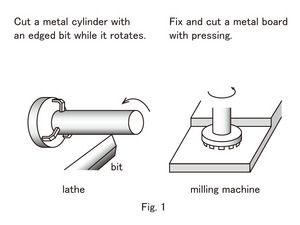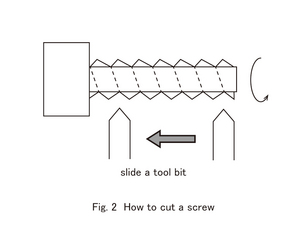Nagoya City Science Museum
TOP > Exhibition Guide > Keyword Search > Starting with "L" > lathe > Cutting
Cutting



Purpose of Exhibition
Cutting means shaving. It is a popular way to process metal. The purpose of this exhibition is to deepen your understanding of metal processing and its application in mass production.
Additional Knowledge
[Two Crafting Machines for Cutting]
There are many ways to cut metal, but there are two primary methods. One is where you turn the metal you want to process and push it on to a tool bit fixed for cutting. A tool called a turning machine is the most important among crafting machines. A crafting machine indicates a machine which produces other machine parts. The other is a way in which the metal that is going to be processed is fixed and pushed onto a tool bit rotating at high speed. A milling machine is a crafting machine (Figure 1).
You can see how a turning machine and a milling machine work in the footage shown. We will explain the background of prominent crafting machines and when they were developed.
[Making the Steam Engine]
The industrial revolution occurred in England in the late 18th century. James Watt's steam engine is the most noticeable invention. The engine requires steam power to move a piston in a cylinder up and down. At this time, the piston needs to come very close to the wall of the cylinder inside so that steam does not leak. For this reason, a machine was required which bores in a big cylinder-shaped piece of metal. Boring means to shave out the inside of the wall, which has an accurate circular shape, by pushing a tool bit attached in a right angle on the axis of rotation. In order for the steam engine to have prevalence, a highly efficient craft machine was required. John Wilkinson created a boring machine for use in a steam engine in 1775.
[Contribution of Henry Moseley]
Henry Moseley, who is called 'the father of the lathe' in England, worked as a skilled blacksmith. A general lathe in the late 18th century was foot-operated. A craftsman held a tool bit for cutting in his hand and he applied it wherever he wanted to cut. This is how it worked, but with this method, accurate work could not be done; it became especially problematic when processing a hard metal like iron. Moseley set a tool platform to fix a tool bit onto it and enabled the platform to make a precise move parallel to a lathe. This moveable platform is called slide rest. The lathe with a slide rest, which Moseley developed, was a revolution for machine processing.
[Thread Cutting Lathe and Compatibility]
Moseley produced the first practical thread cutting lathe in 1800. This lathe moves a slide rest at a constant speed and makes a cylinder-shaped metal into a pile of nails (Figure 2). With this thread cutting technique, compatibility between a bolt and a nut has been achieved.
Until then, a bolt and a nut could only be put together as a specific pair. But now, the fact that we take for granted that any bolt and nut can make a good combination was realized. This is called "compatibility". An essential concept for mass production was born in England during the Industrial Revolution.
[Milling Machine]
We already know that a milling machine is the way in which a tool bit rotating at high speed is pushed on to fixed metal and shaved. This machine tool is good at processing a flat shape and cutting a ditch.
It is said that the oldest milling machine still in use was created by an American, Eli Whitney, in 1820.
Cooperation: Nagoya City Technical High SchoolReference:Article and illustration by Koichi Mabuchi
